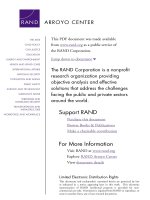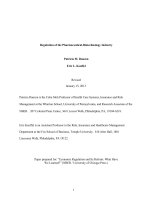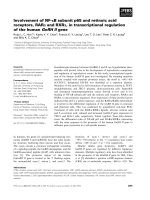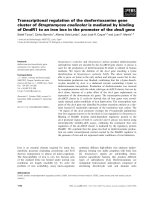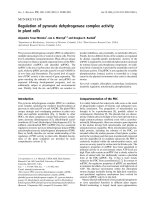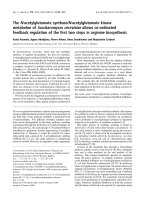Transcriptional regulation of the inducible costimulator (ICOS) in t cells
Bạn đang xem bản rút gọn của tài liệu. Xem và tải ngay bản đầy đủ của tài liệu tại đây (1.68 MB, 151 trang )
TRANSCRIPTIONAL REGULATION OF
THE INDUCIBLE COSTIMULATOR
(ICOS) IN T CELLS
TAN HEE MENG ANDY
NATIONAL UNIVERSITY OF SINGAPORE
2007
TRANSCRIPTIONAL REGULATION OF
THE INDUCIBLE COSTIMULATOR
(ICOS) IN T CELLS
TAN HEE MENG ANDY
B.Sc. (Hons.), M.Sc. (Physics), NUS
A THESIS SUBMITTED
FOR THE DEGREE OF DOCTOR OF PHILOSOPHY
NUS Graduate School for Integrative Sciences and Engineering
NATIONAL UNIVERSITY OF SINGAPORE
2007
ACKNOWLEDGEMENTS
I would like to thank my supervisor, A/Prof Lam Kong Peng, for his guidance and
mentorship and thesis advisory committee members A/Prof Venkatesh Byrappa and
Asst/Prof Ng Huck Hui for rendering technical and professional advice. Special thanks
goes to my wife, Lynn, daughter, Elissa, son, Eugene, parents and parents-in-law who
have been a constant source of moral support and encouragement. In particular, I dedicate
this work to my mother-in-law who passed away during the period of my candidature.
i
TABLE OF CONTENTS
Acknowledgements i
Summary vi
List of Tables viii
List of Figures ix
List of Abbreviations xi
Chapter 1 Introduction
1.1 Two-signal model of T cell activation 2
1.2 Fyn and Lck signaling downstream of TCR 4
1.3 CD28 costimulatory receptor 6
1.4 Inducible costimulator (ICOS) receptor
1.4.1 ICOS structure and signalling 7
1.4.2 ICOS in Th1 and Th2-associated immunity 11
1.4.3 ICOS in immune tolerance 15
1.5 Th1 or Th2 cell lineage decision primed by
TCR and CD28 signalling 16
1.6 Molecular circuitry of Th1 and Th2 cell
differentiation programs 17
1.7 Rationale and aims of study 21
ii
Chapter 2 Materials and Methods
2.1 Mouse strains 24
2.2 T cell lines
2.2.1 Murine EL4 T cell line 24
2.2.2 AE.7 Th1 and CDC35 Th2 cell clones 24
2.3 Chemical inhibitors 25
2.4 Primary murine CD4+ T cells
2.4.1 CD4+ T cell purification 26
2.4.2 CD4+ T cell activation 26
2.4.3 CD4+ T cell differentiation in vitro 26
2.4.4 Retroviral Constructs and Retroviral Transduction of
CD4+ T cells activated by anti-CD3 and anti-CD28 27
2.5 Intracellular cytokine staining (ICS) and
flow cytometric analyses 28
2.6 RNA isolation and real-time RT-PCR analyses 29
2.7 Western blotting 30
2.8 Plasmid constructs 31
2.9 Transient transfections in EL4 cells 32
2.10 Luc reporter assays 33
2.11 siRNA knockdown of T-bet and GATA-3 respectively in
AE7 and CDC35 cells 34
2.12 Chromatin immunoprecipitation (ChIP) 34
2.13 Electrophoretic mobility shift assay (EMSA) 36
iii
Chapter 3 Results
3.1 Induction of ICOS expression by TCR and CD28 co-engagment
3.1.1 Induction of ICOS by TCR and CD28 is subject to
transcriptional control 39
3.1.2 ICOS expression is regulated by distinct pathways downstream of
TCR and CD28 signalling 41
3.1.3 Fyn induces ICOS transcription in part through NFATc2
independently of ERK 46
3.1.4 A 288-bp core promoter region of icos confers
PMA and ionomycin-induced expression of a reporter in vitro 51
3.1.5 Requirement of NFATc2 and ERK-dependent
transcription factor(s) for icos core promoter activity 52
3.1.6 NFATc2 binds icos 288-bp core promoter in vivo and
is affected by Fyn signalling 56
3.1.7 Identification of an ERK-responsive site in the icos promoter 60
3.2 Th lineage-specific regulation of ICOS expression via
distinct icos regulatory regions by T-bet, GATA-3 and NFATc2
3.2.1 ICOS is differentially expressed in different Th cell subsets 65
3.2.2 T-bet or GATA-3 enhances ICOS expression in T cells 68
3.2.3 T-bet is more dominant in activating ICOS transcription in
developing rather than fully differentiated Th1 cells 74
3.2.4 T-bet cooperates with NFATc2 to transactivate
the icos promoter 78
3.2.5 GATA-3 synergises with NFATc2 to regulate gene expression
via an icos 3′UTR element 78
3.2.6 Differential association of T-bet/NFATc2 with
icos promoter and GATA-3/NFATc2 with
icos 3′UTR during Th1 and Th2 differentiation, respectively 82
3.2.7 Histone trimethylation of icos regulatory regions is Th-selective 87
iv
3.3 Post-transcriptional regulation of ICOS expression by
RING-type E3 ubiquitin ligase, roquin 90
3.3.1 Roquin negatively regulates ICOS mRNA stability 91
Chapter 4 Discussion and Future Directions
4.1 Transcriptional regulation of ICOS during early phase of
T cell activation when TCR/CD28 co-stimulation is dominant 95
4.2 Transcriptional regulation of ICOS during T cell
differentiation when lineage-determining cytokines and
transcription factors are dominant 102
4.3 Post-transcriptional regulation of ICOS by
E3 ubiquitin ligase, roquin 115
4.3 Conclusion 116
Bibliography 118
List of Publications 136
v
SUMMARY
The inducible costimulator (ICOS), a member of the CD28 family of
costimulatory molecules, is rapidly induced upon T cell activation. Although the critical
role of ICOS in T-cell-mediated immunity is well documented, little is known of the
intracellular pathways that modulate ICOS expression. We first investigated ICOS
induction during early activation of T cells by T cell receptor (TCR) and CD28 co-
engagement. We found that the ectopic expression of the transcription factor NFATc2 or
a constitutively active form of MEK2 that activates ERK amplified icos transcription by
acting on a 288-bp region of the icos promoter in luciferase reporter assays. We also
identified a site on the promoter that is sensitive to ERK signalling and further showed
the in vivo binding of NFATc2 to the promoter, the intensity of which is diminished when
Fyn signalling is ablated. The normal activation of ERK but reduced nuclear
translocation of NFATc2 in Fyn-deficient (Fyn
-/-
) CD4+ T cells imply that Fyn and
NFATc2 act in a common axis, separate from ERK, to drive icos transcription.
Following initial activation, T cells differentiate into Th1 or Th2 cells, depending
on the nature of the immune response. Because ICOS expression was found to be
differentially expressed in these cells, we next examined the control of ICOS expression
by Th1-specific T-bet and Th2-specific GATA-3, which drive respective lineage
commitment, as well as NFATc2, which is broadly expressed across lineages. We
observed that the over-expression of T-bet or GATA-3 could enhance, and NFATc2
could further synergize with either of them to increase, icos transcription. While T-bet
acted on the icos promoter, GATA-3 operated via an icos 3′UTR element. Interestingly,
NFATc2 was found to bind promiscuously the icos promoter in developing Th0, Th1 and
vi
Th2 cells but became selectively associated with T-bet at the promoter and with GATA-3
at the 3′UTR in fully differentiated Th1 and Th2 cells, respectively. The binding
dynamics of these transcription factors coincided with the chromatin accessibility of
these regulatory regions in the different Th cells as assessed by histone trimethylation.
Finally, we also found ICOS expression to be regulated at the post-transcriptional
level by a recently discovered RING-type E3 ubiquitin ligase, roquin. Enforced
expression of wild-type but not a sanroque mutant form of roquin accelerated the decay
of ICOS mRNA in a T cell line. Collectively, our findings indicate that during the initial
TCR/CD28-mediated activation of T cells, Fyn-calcineurin-NFATc2 and MEK2-ERK1/2
signalling pathways cooperate to induce ICOS expression. As Th cells differentiate along
the Th1 or Th2 lineage, the non-selectively expressed NFATc2 synergises with Th-
restricted T-bet or GATA-3 in a temporally evolving fashion to direct icos transcription
via distinct regulatory elements in Th cells undergoing differentiation. In addition to the
transcriptional control of ICOS expression in Th cells, there exists a post-transcriptional
level of ICOS regulation, in terms of mRNA turnover, mediated in part by the ROQ
domain of roquin.
vii
LIST OF TABLES
Table 1.1 Comparison of CD28 family of receptors.
viii
LIST OF FIGURES
Figure 1.1 Two-signal model of T cell activation.
Figure 1.2 Cytokines and transcriptional apparatus governing Th1 and Th2
differentiation.
Figure 3.1 ICOS expression is induced at the transcriptional level upon T cell
activation.
Figure 3.2 ICOS induction by TCR and CD28 engagement is regulated by distinct
downstream signaling pathways.
Figure 3.3 Induction of ICOS transcription by ectopic expression of MEK2 and
NFATc2.
Figure 3.4 PP2 treatment affects NFATc2 nuclear translocation but not Erk
activation.
Figure 3.5 Transactivation of the putative icos promoter by NFATc2 and ERK
signalling.
Figure 3.6 ChIP analyses of NFATc2 binding to the icos minimal promoter.
Figure 3.7 Identification of an ERK-sensitive site on the icos promoter.
Figure 3.8 ICOS is differentially expressed in different Th cell subsets.
Figure 3.9 Ectopic expression of T-bet or GATA-3 enhances ICOS expression in T
cells.
Figure 3.10 Knockdown of T-bet or GATA-3 reduces icos transcripts in AE7 Th1 and
CDC35 Th2 cell lines.
Figure 3.11 The amount of icos transcripts is reduced in the absence of T-bet in
developing but not fully differentiated Th1 cells.
Figure 3.12 Nuclear translocation of NFATc2 precedes that of phospho-ERK in
developing Th cells.
Figure 3.13 T-bet and GATA-3 act through distinct icos regulatory regions to regulate
gene expression.
Figure 3.14 Differential association of T-bet, GATA-3 and NFATc2 with the icos
regulatory regions during de novo Th1 and Th2 cell differentiation.
ix
Figure 3.15 Active ICOS transcription correlates with the chromatin accessibility of
the icos promoter or 3’UTR during Th cell differentiation.
Figure 3.16 The level of icos transcript is more severely diminished by ectopic
expression of roquin WT than M199R mutant in EL4 cells.
Figure 4.1 Proposed model for transcriptional regulation of ICOS expression by
Fyn-calcineurin-NFATc2 and MEK2-ERK1/2 signalling in T cells.
Figure 4.2 Model of feed-forward regulatory circuits linking ICOS expression,
cytokine networks and transcriptional machinery directing A, Th1 and B,
Th2 cell differentiation.
x
LIST OF ABBREVIATIONS
Ab antibody
AILIM activation-inducible immunomodulatory molecule
AP-1 activator protein-1
APC antigen presenting cell
Bcl B-cell lymphoma
CD cluster of differentiation
ChIP chromatin immunoprecipitation
CTLA-4 cytotoxic T lymphocyte-associated antigen-4
DC dendritic cell
EAE experimental autoimmune encephalomyelitis
Elf-1 E74-like factor-1 (Elf-1)
Elk-1 E26-like protein-1
EAMG experimental autoimmune myasthenia gravis
EMSA electrophoretic mobility shift assay
ERK extracellular signal-regulated kinase
Ets-1 E26 transformation-specific-1
FoxP3 forkhead box protein 3
GATA-3 GATA binding protein 3
GFP green fluorescent protein
GVHD graft versus host disease
ICOS inducible costimulator
ICS intracellular staining
xi
IFN-γ interferon-gamma
Ig immunoglobulin
IL interleukin
iono ionomycin
JNK c-Jun NH
2
-terminal kinase
LAT linker for activated T cells
LICOS ligand for ICOS
LSF late SV40 transcription factor
luc luciferase
MAPK mitogen-activated protein kinase
MHC major histocompatibility complex
MOG myelin oligodendrocyte glycoprotein
mTOR mammalian target of rapamycin
NFAT nuclear factor of activated T cells
NF-κB nuclear factor binding immunoglobulin κ light chain enhancer in B cells
PI-3K phosphatidylinositol-3-kinase
PLC-γ1 phospholipase C-gamma1
PMA phorbol-12-myristate-13-acetate
RAPA rapamycin
SAP SLAM-associated protein
SCID severe combined immunodeficiency
SH Src homology
SLAM signalling lymphocytic activation molecule
xii
SLP-76 signaling leukocyte protein of 76 kD
STAT signal transducer and activator of transcription
SV40 simian virus 40
Syk spleen tyrosine kinase
T-bet T-box expressed in T cells
TCR T cell receptor
T
FH
follicular B helper T
Th T helper
TNF tumour necrosis factor
TNFR tumour necrosis factor receptor
T
reg
regulatory T
TSS transcription start site
UTR untranslated region
WM wortmannin
WT wild-type
XLP X-linked lymphoproliferative syndrome
ZAP-70 zeta-associated protein of 70 kD
xiii
CHAPTER 1
INTRODUCTION
1.1 Two-signal model of T cell activation
Mounting an appropriate immune response depends on the careful regulation of
lymphocyte activation. To this end, lymphocytes require two independent signals to
become optimally activated. The first, an antigen-specific signal is sent via the unique
antigen receptor: TCR on T cells or surface Ig on B cells. The TCR is cross-linked by an
agonist peptide or antigen (Ag) presented in the context of the major histocompatibility
complex (MHC) II for cluster of differentiation (CD)4+ and MHC I for CD8+ T cells on
the surface of antigen presenting cells (APCs), which include macrophages, dendritic
cells (DCs) and B cells. The second signal, termed costimulation, is critical for full
activation, sustaining cell proliferation, inducing differentiation and preventing anergy
and/or apoptosis (Frauwirth and Thompson, 2002; Chambers and Allison, 1997;
Chambers, 2001), and in the context of T cells, is delivered by costimulatory ligands
expressed on activated APCs (Coyle and Gutierrez-Ramos, 2001; Sharpe and Freeman,
2002; Greenwald et al., 2005) (Figure 1.1). The two most prominent superfamilies
mediating costimulation are those of B7/CD28 (Carreno and Collins, 2002; Lenschow et
al., 1996b; Shahinian et al., 1993) and tumour necrosis factor / receptor (TNF/TNFR)
(Croft, 2003a; Croft, 2003b), the signals of which are in turn negatively regulated by
inhibitory receptors expressed upon lymphocyte activation. Members of the CD28 family
of receptors, part of the broader immunoglobulin (Ig) superfamily, are type I
transmembrane glycoproteins and share 20 – 35% identity in their amino acid sequences
(Table 1.1). Despite such low homology in primary amino acid composition, these
molecules share a similar secondary structure: single Ig V and Ig C-like extracellular
2
Figure 1.1 Two-signal model of T cell activation.
Table 1.1 Comparison of CD28 family of receptors.
CD28 CTLA-4 ICOS PD-1 BTLA
% identity
100 % 30 % 27 % 23 % 23 %
Chromosome
Human
Mouse
2q33
1C1
2q33
1C2
2q33
1C2
2q37
1D
3q13.2
16A1
Structure
Ligand
binding motif
Cytoplasmic
domain
MYPPPY
PI3K
motif,
PP2A
MYPPPY
PI3K motif,
PP2A,
?SHP2
FDPPPF
PI3K motif
?
ITIM motif,
SHP2, ITSM
motif, SHP1
?
Two ITIM
motifs
Expression
Cell type
T T T, NK T, B, M T, B
T = T cell; B = B cell; NK = natural killer cell; M = macrophage; ITAM = immunoreceptor tyrosine-based
activation motif; ITIM = immunoreceptor tyrosine-based inhibition motif; ITSM = immunoreceptor
tyrosine-switch motif.
ICOSICOSL
CD28B7.1, B7.2
TCR/CD3
MHCII
T cell
APC
foreign peptide
first signal
second (costimulatory) signal
optimal activation and
effector differentiation
3
domains. Four cysteine residues, which are involved in the formation of the disulfide
bonds of the Ig V and Ig C domains, are well-conserved. The receptors for the B7 family
are members of the CD28 family, and possess a single Ig V-like extracellular domain.
Their cytoplasmic tails contain putative Src homology (SH)2- and SH3-motifs thought to
be involved in signal transduction (Rudd and Schneider, 2003; Wang and Chen, 2004).
APC-expressed B7-1 (CD80) and B7-2 (CD86) bind the costimulatory CD28 and
inhibitory cytotoxic T lymphocyte-associated antigen (CTLA)-4 on T cells. Engagement
of the prototypical CD28 receptor on naïve T cells by either B7-1 or B7-2 augments the
TCR signal (Riley and June, 2005), which leads to enhanced interleukin (IL)-2
transcription (Civil and Verweij, 1995), expression of CD25 (IL-2Rα), and entry into cell
cycle (Parry et al., 2003). Critical survival, as distinct from proliferation, signals are also
conferred via the B-cell lymphoma (Bcl)-X
L
pathway (Burr et al., 2001; Okkenhaug et
al., 2001; Sperling et al., 1996; Boise et al., 1995; Marinari et al., 2004). In contrast, the
engagement of CTLA-4 delivers negative signals, which inhibit IL-2 synthesis, cell cycle
progression and terminate T cell responses.
1.2 Fyn and Lck signalling downstream of TCR
The src-family tyrosine kinases p59
fyn
(Fyn) and p56
lck
(Lck) are expressed in T
cells and constitute the most proximal signalling molecules to be activated downstream of
TCR. They are responsible for the initial tyrosine phosphorylation of the receptor, leading
to the recruitment of the zeta-associated protein of 70 kD (ZAP-70) tyrosine kinase, as
well as the subsequent phosphorylation and activation of ZAP-70, linker for activated T
cells (LAT), and phospholipase C-gamma1 (PLC-γ1), leading to calcium flux, activation
4
of calcineurin and dephosphorylation and nuclear translocation of the nuclear factor of
activated T cells (NFAT). Although closely related, these signalling molecules have
distinct functions during development, maintenance and activation of peripheral T cells.
For example, during thymopoiesis, albeit Fyn can substitute for a subset of signals which
Lck is uniquely able to provide for pre-TCRβ selection, Fyn is largely dispensable for
gross T cell development (Appleby et al., 1992). In naïve peripheral T cells, either Lck or
Fyn can transmit TCR-mediated survival signals, and yet only Lck is able to trigger TCR-
mediated expansion signals under lymphopenic conditions. Stimulation of naïve T cells
to proliferate and produce IL-2 by antigenic stimuli is also severely compromised in the
absence of Lck, but hardly impaired by the absence of Fyn. Interestingly, more profound
defects in the Lck-dependent signalling pathway were observed with stimulation of Fyn-
deficient T cells with anti-CD3 and anti-CD28 antibodies, which was rescued by
coaggregation of CD3 and CD4 (Sugie et al., 2004). This suggests that Fyn positively
regulates Lck when stimulation of CD4+ T cells is restricted to TCR with no involvement
of MHCII and CD4 co-receptor.
Another study, examining the ability of Fyn to mediate TCR signal transduction
in an Lck-deficient Jurkat T-cell line (JCaM1), found that the signalling leukocyte protein
of 76 kD (SLP-76) adapter protein, the Ras mitogen-activated protein kinase (MAPK)
and the phosphatidylinositol 4,5-biphosphate signalling pathways, but not NFAT and IL-
2 production, were activated in the absence of Fyn (Denny et al., 2000). This indicates
Fyn mediates an alternative form of TCR signalling which is independent of ZAP-70
activation and imply which Src family kinase is used to initiate signalling may dictate the
outcome of TCR signal transduction, at least in human T cells.
5
1.3 CD28 costimulatory receptor
CD28, being constitutively expressed, is critical for the activation of naive T cells
and plays an important role in the initial phase of an immune response, while not being as
effective in regulating effector and memory T cell responses. Despite its status as a key
costimulatory molecule, CD28 does not account for all costimulatory functions in T cells.
Immune responses are not totally nullified in the absence of CD28 because mice lacking
CD28 exhibit normal Th cell activation and are able to produce IgG in response to
infections by some viruses (Whitmire and Ahmed, 2000). In addition, priming of T helper
(Th) cells, Ig class switching and IgM responses are reportedly normal in CD28-deficient
mice (Wu et al., 1998), while memory Th2 effector cells can develop in the absence of
B7-1/2 and CD28 interactions, after sensitisation with an intestinal nematode parasite
Heligmosomoides polygyrus (Ekkens et al., 2002). Reactivation of antigen-experienced
memory and effector T cells are far less dependent than naive T cells on CD28/B7
costimulation (London et al., 2000), consistent with the idea that CD28 signalling is less
important for the function of the former population of T cells. CD28 deficiency
paradoxically promotes the development of diabetes in the nonobese diabetic (NOD)
mouse strain (Lenschow et al., 1996a), although this observation was later attributed to
the profound decrease of immunoregulatory CD4+CD25+ T cells in CD28-deficient
NOD mice. Another study found that the production of effector cytokines such as
interferon (IFN)-γ and IL-4 can be stimulated to normal levels by APCs lacking both B7-
1 and B7-2 (Schweitzer et al., 1997). Furthermore, naive TCR-transgenic T cells lacking
CD28 are able to initiate a primary Ag-specific response, but fail to sustain proliferation
as the cells acquire effector status (Lucas et al., 1995). This is possibly due to
6
compensation for costimulatory requirement by prolonged TCR signalling (Acuto and
Michel, 2003), made obvious in the case of T cells genetically engineered to express a
TCR transgene, and/or functional substitution for CD28 by other costimulatory
molecules. These results suggest that other molecules can compensate for the absence of
CD28 signalling.
1.4 Inducible costimulator (ICOS) receptor
1.4.1 ICOS structure and signalling
One such recently discovered candidate belonging to the CD28 family is the
inducible costimulator or ICOS. Alternatively termed activation-inducible lymphocyte
immunomodulatory molecule (AILIM), the rat ICOS homologue (Tamatani et al., 2000;
Tezuka et al., 2000), or H4 (Buonfiglio et al., 2000), ICOS is a T-cell specific molecule
structurally and functionally related to CD28 and shares 30% to 40% sequence similarity
to CD28 and CTLA-4 but does not carry the conserved MYPPPY motif necessary for
binding B7-1 and B7-2 (Beier et al., 2000; Hutloff et al., 1999) (Table 1.1). Murine, rat
and canine ICOS share respectively 71.7% (Mages et al., 2000), 67% (Tamatani et al.,
2000) and 79% (Lee et al., 2004b) sequence identities with their human counterpart. It is
rapidly induced on T cells upon activation and binds its cognate ligand B7-H2 (also
known as GL50 (Ling et al., 2000), B7RP-1, B7h, LICOS or ICOSL) which is expressed
constitutively on APCs, including B cells and macrophages, and can be induced in
cultured fibroblasts and non-lymphoid tissues by treatment with inflammatory agents
such as LPS and TNF-α (Liang and Sha, 2002; Swallow et al., 1999). LICOS was first
identified as the homologue of B7-1 expressed by chicken macrophages and of
7
mammalian B7-H2 and may be the contemporary form of a primordial vertebrate
costimulatory ligand (Brodie et al., 2000).
Similar to CD28 signalling, ICOS engagement costimulates T cell proliferation,
promotes Th differentiation and production of IFN-γ, TNF-α, IL-4, IL-5, IL-10 and IL-13
(Beier et al., 2000; Coyle et al., 2000; Nurieva et al., 2003b; Vieira et al., 2004;
Yoshinaga et al., 1999) but unlike CD28, it does not enhance IL-2 production, as ICOS
blockade did not attenuate IL-2 secretion by mice administered superantigen (SAg)
(Gonzalo et al., 2001a). However, ICOS strikingly potentiated secretion of IL-2, IFN-γ
and TNF-α, but not IL-4 in human naive CD4+ T cells stimulated through CD3 and
CD28 (Mesturini et al., 2006), alluding to differences between mouse and human ICOS
signalling. It has been suggested that ICOS signalling may be more important for
regulating activated, effector and memory T cells (Coyle et al., 2000), whereas CD28
functions to prime naive T cells, given its absence or very low levels of expression on
naive T cells and its up-regulation upon stimulation in both CD4+ and CD8+ effector T
cells (Beier et al., 2000; Tafuri et al., 2001; Yoshinaga et al., 1999). Consistent with this
view, delayed ICOS blockade during chronic allograft rejection, the progression of which
is mediated by effector/memory T cells, was associated with down-regulation of local
intragraft expression of several cytokines and chemokines (Kashizuka et al., 2005).
Blocking ICOS on effector T cells during the efferent phase of the immunopathogenesis
of murine experimental autoimmune encephalomyelitis (EAE) abrogated disease
(Rottman et al., 2001). Similar blockade during the effector phase of murine experimental
autoimmune uveoretinitis ameliorated disease, while doing so during the induction phase
had no significant effect (Usui et al., 2006b). Moreover, ICOS/B7-H2 interactions were
8
shown to play an important role in controlling the entry of effector/memory T cells across
the endothelium into inflamed tissues in the periphery via activating the PI3-kinase/Akt
and Rho family cascades (Nukada et al., 2006; Okamoto et al., 2004a).
Initial characterisation of either ICOS or B7-H2 deficient mice revealed a primary
phenotype of severe defects in germinal centre (GC) formation and B cell
immunoglobulin class switching. (Dong et al., 2001a; McAdam et al., 2001; Tafuri et al.,
2001; Wong et al., 2003; Dong et al., 2001b). ICOS deficient mice were highly resistant
to clinical experimental autoimmune myasthenia gravis development, exhibited defective
T cell-mediated humoral immunity, and had a diminutive GC reaction in secondary
lymphoid tissues (Scott et al., 2004). Consistent with the pivotal role of ICOS in GC
development, ICOS has been implicated in the maintenance of CXCR5+ follicular B
helper T cells (T
FH
) in vivo (Akiba et al., 2005). Murine ICOS deficiency is associated
with a severe reduction of CXCR5+CD4+ GC Th cells (Bossaller et al., 2006). Human
ICOS deficiency, on the other hand, results in a clinical phenotype indistinguishable from
the monogenic disease known as adult-onset common variable immunodeficiency
(Grimbacher et al., 2003; Warnatz et al., 2005). In the context of viral and parasitic
infections, ICOS regulates CD28-dependent and CD28-independent CD4+ T cell subset
polarisation but not cytotoxic T lymphocyte responses (Bertram et al., 2002; Kopf et al.,
2000; Loke et al., 2005). In addition, a recent study demonstrated a critical role for ICOS
costimulation in immune containment of pulmonary influenza virus infection
(Humphreys et al., 2006). Substantial similarity between the immune phenotype and
responses of ICOS and B7-H2 deficient mice (Dong et al., 2001a; Mak et al., 2003;
McAdam et al., 2001; Tafuri et al., 2001; Wong et al., 2003), combined with interaction
9
studies using recombinant protein (Nurieva et al., 2003b; Swallow et al., 1999), brought
about the notion of a monogamous receptor-ligand relationship between ICOS and B7-
H2. So far, there has been a paucity of evidence to suggest otherwise.
ICOS expression is optimally induced when both TCR and CD28 are activated,
whereas its up-regulation is significantly reduced in the absence of CD28/B7 interaction
(Coyle et al., 2000; McAdam et al., 2000), although physiologically relevant levels of
ICOS are expressed on T cells subjected to submitogenic stimulation with anti-CD3
antibody (Ab) (McAdam et al., 2000; Yoshinaga et al., 1999). It is therefore anticipated
that one of the possible reasons behind attenuated ICOS/B7-H2 signalling in CD28 KO
mice is defective ICOS up-regulation. To address the issue of the costimulatory capacity
of ICOS in the absence of CD28, mice doubly deficient in CD28 and ICOS were
generated and their Ab responses against environmental Ags, T-dependent protein Ags,
and vesicular stomatitis virus were compared with those of CD28 deficient and wild-type
(WT) counterparts. Doubly deficient mice manifested profound defects in their immune
responses that far exceeded those observed in CD28 deficient mice, suggesting that in the
absence of CD28, ICOS assumes the major T cell costimulatory role for humoral immune
responses (Suh et al., 2004). Besides its dominant role in humoral immunity, ICOS
signalling is also involved in the proliferation of effector T cells, driving the initial clonal
expansion of primary and primed Th1 and Th2 cells in response to immunisation (Smith
et al., 2003). Furthermore, its signalling regulates DC-mediated clonal expansion of
human Th2, but not Th1 cells (Vieira et al., 2004), and dictates the expansion of polarised
Th subsets developed in response to infection with Trichuris muris or Toxoplasma gondii
(Wilson et al., 2006).
10


